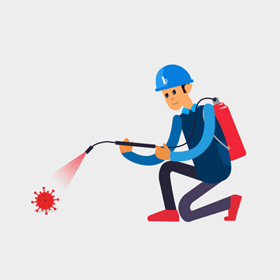

House sanitizing is a comprehensive process aimed at eliminating harmful microorganisms, such as bacteria, viruses, fungi, and other pathogens, from various surfaces within a home. The primary goal is to create a hygienic environment that reduces the risk of infections and promotes the well-being of occupants. This practice has gained significant importance, especially in the context of global health concerns, such as the COVID-19 pandemic.
The first step in house sanitizing involves identifying high-touch surfaces, which are frequently contacted by household members. These may include doorknobs, light switches, countertops, faucets, and electronic devices. These surfaces become breeding grounds for bacteria and viruses due to constant human interaction, making them crucial targets for sanitization.
Common sanitizing agents include disinfectants, which are chemicals designed to kill or inhibit the growth of microorganisms. Different surfaces may require specific types of disinfectants to ensure efficacy without causing damage. For example, a disinfectant suitable for kitchen countertops might differ from the one used on electronic gadgets.
Cleaning and sanitizing are distinct processes, with cleaning involving the removal of dirt and impurities from surfaces, and sanitizing focusing on eliminating harmful microorganisms. While cleaning is essential for maintaining a tidy living space, sanitizing takes hygiene to the next level by addressing potential health risks associated with microbial contamination.
House sanitizing is particularly crucial during disease outbreaks, where preventing the spread of infectious agents is paramount. The COVID-19 pandemic, for instance, highlighted the importance of thorough and regular sanitization practices to curb the transmission of the virus within households.
In addition to chemical disinfectants, ultraviolet (UV) light has gained popularity as an effective sanitizing tool. UV-C light, in particular, has demonstrated the ability to destroy the genetic material of microorganisms, rendering them unable to replicate. UV sanitization devices are used to target specific areas or entire rooms, providing an additional layer of protection against pathogens.
The frequency of house sanitizing depends on various factors, including the number of occupants, the presence of vulnerable individuals, and the overall cleanliness of the living space. High-traffic areas and commonly used items may require more frequent sanitization to maintain a consistently hygienic environment.
While house sanitizing is crucial for health and safety, it is essential to strike a balance to avoid overuse of harsh chemicals, which may have adverse effects on indoor air quality and contribute to environmental concerns. Choosing eco-friendly and less toxic sanitizing agents can mitigate potential negative impacts.
In conclusion, house sanitizing is a multifaceted process that goes beyond routine cleaning to target and eliminate harmful microorganisms from various surfaces within a home. In the face of global health challenges, maintaining a clean and sanitized living environment has become a key component of public health measures. By adopting appropriate sanitization practices, individuals can contribute to safeguarding their homes and promoting the well-being of their families.
Please reach out if you have any questions or need further clarification.
Copyright 2013 Orbit pest control inc.. all right reserved - Site developed by StarWebies.